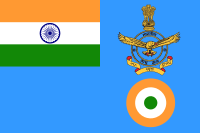Ronald Ivelaw-Chapman
Air Chief Marshal Sir Ronald Ivelaw-Chapman, GCB, KBE, DFC, AFC (17 January 1899 – 28 April 1978) was a senior commander in the Royal Air Force in the middle of the 20th century and the penultimate RAF commander-in-chief of the Indian Air Force.
Sir Ronald Ivelaw-Chapman | |
|---|---|
| Nickname(s) | Chaps |
| Born | 17 January 1899 British Guiana |
| Died | 28 April 1978 (aged 79) |
| Allegiance | United Kingdom |
| Service/ | British Army (1917–18) Royal Air Force (1918–57) |
| Years of service | 1917–1957 |
| Rank | Air Chief Marshal |
| Commands held | Home Command (1952) Indian Air Force (1950–51) No. 38 Group (1945–46) RAF Elsham Wolds (1943–44) RAF Linton-on-Ouse (1940–41) |
| Battles/wars | First World War Kabul Airlift Second World War |
| Awards | Knight Grand Cross of the Order of the Bath Knight Commander of the Order of the British Empire Distinguished Flying Cross Air Force Cross Mentioned in Despatches |
| Other work | Director of Resettlement at the Ministry of Labour President of the Council of Cheltenham College |
Early life and the First World War
Ronald Ivelaw-Chapman was born in British Guiana to a successful merchant. He came to England with his parents in 1903 and attended Cheltenham College.[1] He joined the Royal Flying Corps in 1917 and served as a Bristol Fighter pilot on the western front with 10 Squadron in the last eleven months of the war.[2]
Between the wars
In January 1929 Ivelaw-Chapman, then a flight-lieutenant in the RAF, participated in the Kabul Airlift, a successful evacuation of the British Legation in Kabul amidst a civil war and a bitter winter. On 27 January a Kabul-bound Vickers Victoria, piloted by Ivelaw-Chapman, was forced to make an emergency landing in the mountainous Surobi District. Rescued by an Afghan royalist officer, Ivelaw-Chapman was awarded the Air Force Cross for his handling of the incident.
Second World War
At the outbreak of the Second World War Ivelaw-Chapman, now a wing commander, was part of the operations staff of RAF Bomber Command headquarters.[2] In June 1940 he was promoted to group captain and was appointed station commander at RAF Linton-on-Ouse, a No. 4 Group bomber station near York.[2] In 1941 he returned to a staff job at the Air Ministry involved in D-Day planning.[2] In 1943 he was again appointed a station commander at RAF Elsham Wolds, a No. 1 Group bomber station.
On the night of the 6/7 May 1944 Ivelaw-Chapman was flying as second pilot of a No. 576 Squadron Avro Lancaster on a mission to bomb an ammunition dump at Aubigne in France. His aircraft was shot down by a night fighter and Ivelaw-Chapman went on the run.[2] Because of his experience and knowledge Churchill ordered the French resistance to do all they could to help him return to England, he was to be killed if he was in danger of being captured by the Germans.[2] He was captured by the Gestapo on 8 June 1944, the most senior Bomber Command officer to have been captured by the Germans. Churchill's fear was unfounded as the Germans did not realise his importance and he was treated as an ordinary prisoner of war.[2]
Post war
After the war he was promoted to air vice marshal and assumed command of No. 38 Group at Marks Hall, Earls Colne, Essex. In 1950 he became an air chief marshal and accepted the post of Commander-in-Chief of the newly formed Indian Air Force. On his return to the UK he became Air Officer Commanding-in-Chief at Home Command in March 1952, Deputy Chief of the Air Staff in November 1952 and Vice-Chief of the Air Staff in 1953 before he retired in 1957.[2]
Family
In 1930 he married his fiancée Margaret.[1]
References
Notes
- Ronald Ivelaw-Chapman biography
- Falconer 2003, page 209
Bibliography
- Falconer, Jonathan (2003). Bomber Command Handbook 1939–1945. Stroud, England: Sutton Publishing. ISBN 0-7509-3171-X.
- Ivelaw-Chapman, John (1993). High Endeavour. Barnsley, South Yorkshire: Leo Cooper/Pen & Sword Books. p. 164. ISBN 0-85052-316-8.
- Ivelaw-Chapman & Baker, Sir Ronald & Anne (1975). Wings Over Kabul. London: Kimber. ISBN 0-7183-0184-6.
- Air of Authority – A History of RAF Organisation – Air Chief Marshal Sir Ronald Ivelaw-Chapman
- Bharat-rakshak.com – Air Chief Marshal Sir Ronald Ivelaw-Chapman
| Military offices | ||
|---|---|---|
| Preceded by Sir Thomas Elmhirst |
Commander in Chief, Indian Air Force 1950–1951 |
Succeeded by Sir Gerald Gibbs |
| Preceded by Sir Robert Foster |
Air Officer Commanding-in-Chief Home Command March – November 1952 |
Succeeded by Sir Harold Lydford |
| Preceded by Sir John Baker |
Deputy Chief of the Air Staff 1952–1953 |
Succeeded by Sir Thomas Pike |
| Vice-Chief of the Air Staff 1953–1957 |
Succeeded by Sir Edmund Hudleston | |
